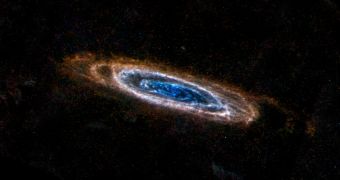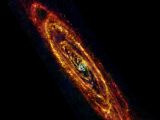Andromeda is our nearest galactic neighbor, our nearest big galactic neighbor at least, so it's been an object of interest for a long time. It's a spiral galaxy like our own and visible even with relatively simple telescopes.
If you have the mighty Herschel at your disposal though, Andromeda is more than visible, it's absolutely gorgeous.
A couple of the latest photos of Andromeda, shot with the Herschel Space Telescope, are proof to that. Both are shot in infrared, Herschel is an infrared telescope, but at different wavelengths resulting quite different images.
Both images are from the far end of the infrared spectrum so they reveal even the coolest objects. In the first, the coldest specs of dust are shown in red, they're only a few tens of degrees above absolute zero. The original infrared light had a 500 micron wavelength.
Slightly hotter regions are green and then blue with the galactic center, the warmest place, also being the bluest region.
Green regions are luminous in 350-micron infrared light while blue ones are in 250-micron infrared light. All of this data is captured with Herschel's SPIRE instrument, which is tuned to the longest infrared wavelengths.
The second image combines SPIRE data with that received from the Photodetecting Array Camera and Spectrometer (PACS) instrument. In this image, blue and green areas are warmer and represent locations with active star formation.

 14 DAY TRIAL //
14 DAY TRIAL // 
